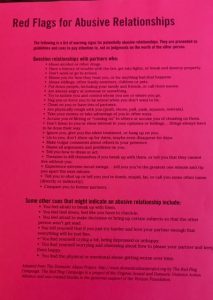Domestic violence—in its many forms—is so prevalent that all writers should be informed, should make conscious decisions about whether to include this common aspect of intimate relationships in their work, and if so, to represent such relationships accurately. All the statements that follow can easily be verified online.
So, just how common is it? 1 in 3 women and (surprising to me) 1 in 4 men have been victims of some form of physical violence by an intimate partner. On average, nearly 20 people per minute are physically abused in the United States. Another way of looking at these numbers: if none of your characters suffers physical violence, you probably aren’t writing realistically. 1 in 4 women and 1 in 7 men are victims of severe violence by an intimate partner. Intimate partner violence accounts for 15% of all violent crime.
Know the norms and choose when to go against them with your characters/plot.
- Women between the ages of 18 and 24 are most commonly abused by an intimate partner.
- Only 34% of people who are injured by intimate partners receive medical treatment for their injuries.
- Being the recipient of domestic violence is correlated with a higher incidence of depression and suicidal behavior.
- 85% of domestic abuse sufferers are women
- 40% of gay or bisexual men experience intimate partner violence, compared to 25% of men overall
- 50% of lesbian women experience domestic violence, but not necessarily intimate partner violence
- A transgender person is 2.6 times more likely to suffer intimate partner violence than a non-LGBT person
- 50% of LGBT people murdered by their intimate partners were people of color
Why stay in an abusive relationship? Before I volunteered at Hanover Safe Place, I couldn’t fathom why a woman in an abusive relationship—especially a physically abusive one—would stay in that relationship. At first glance, it seems to fly in the face of a basic tenet of human behavior: people always choose the best perceived alternative. On closer look, staying is often the best perceived alternative.
- 98% of all domestic violence cases include financial abuse—i.e., the abuser controls the money, leaving the victim with no financial resources to leave. This is the number one reason victims stay or return to abusive relationships. If I am remembering correctly, on average a woman will leave and return seven times before leaving for good.
- Fear of being killed. Three women are murdered every day by a current or former male partner. A woman is 70 times more likely to be murdered in the few weeks after leaving an abusive partner than at any other time in the relationship.
- Threats against children or other family members
- Such low self-esteem that the woman feels she deserves it
Staggering as the figures are, still most of us have not experienced domestic/intimate partner violence. In addition, you might just not want to go there with your writing. But you can still create tension by inserting red flags signaling potentially abusive relationships.
For more information or more targeted information, search the web.
- Domestic Violence and Psychological Abuse
- Domestic Violence and Economic Abuse
- Domestic Violence and Stalking
- Dating Violence and Teen Domestic Violence
- Male Victims of Intimate Partner Violence
- Domestic Abuse in Later Life
- American Indian/Alaskan Native Women and Domestic Violence
- Domestic Violence and Guns





